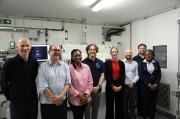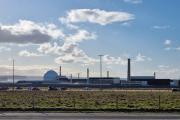CYCLOPS Takes You Where No Man Has Gone - Inside The Reactor Core - Watch The Video
17th March 2007
Another ground-breaking device is leading the way with decommissioning Dounreay's Prototype Fast Reactor (PFR). The innovative purpose built device, nicknamed Cyclops, was designed in-house by UKAEA's specialist design team. It has the combined purpose of measuring radiation and videoing capabilities in an extreme environment where temperatures are in excess of 230�C in addition to the high radiation levels.
The specialist nitrogen cooled camera was lowered eight metres into the reactor on a heat resistant umbilical service line, which has allowed a clear view of the upper regions of the reactor and deep inside the core for the first time in over thirty years.
Appearing like a honeycomb in a bee-hive, the pattern which once housed the fuel pins is clearly visible, and appears to be in remarkably good condition despite the passage of time.
With the camera in the reactor performing the visual inspection, the team took the opportunity to undertake the first in a series of radiation surveys which will assist with reactor decommissioning and ultimately demolition of PFR.
Watch The Video
UKAEA's Calder Bain, responsible for the design of the equipment, said: "A considerable amount of innovation was required to build PFR and there will be a continual requirement for pioneering methods to take a reactor of this complexity apart. This type of work gives young engineers the opportunity to put their innovative skills and knowledge into practice."
Dr Jim McCafferty, PFR decommissioning manager said: "The reactor dismantling project is critical to the decommissioning of PFR. The team in place, led by Ron Hibbert, have well developed plans in operation, however decommissioning a fast reactor of this size would not be possible without the continued support of our highly skilled contractors who have worked tirelessly to support us in achieving safe delivery of challenging projects such as this."
PFR operated for twenty years from 1974 until 1994. 1500 tonnes of liquid sodium metal was used as the coolant to transfer the heat from the reactor core through to the three secondary circuits to asteam-generating plant for electricity production. All the nuclear fuel was removed from the reactor following its closure and the next phase of decommissioning is to complete the disposal of the remaining sodium using the revolutionary Water Vapour Nitrogen process (WVN) process following the destruction of the majority of the sodium via the sodium disposal plant. PFR had the dual role of providing power to the national grid and offering unique research and development facilities. PFR provided information for the future design and operation of large commercial fast reactor stations and had an electrical output of 250MW, which was enough electricity to supply a city the size of Aberdeen.
Related Businesses
Related Articles
UKAEA develops 3D printing for fusion components
At its recently opened Central Support Facility (CSF), UKAEA has commissioned an electron beam additive manufacturing machine that can be used to incorporate tungsten into components, alongside a selective laser manufacturing machine. Fusion can play a key role in a global low carbon energy future.Advancing Fusion Remote Maintenance: Industry Collaboration Driving Innovation
As part of the Fusion Futures (FF) programme, UKAEA's Remote Applications in Challenging Environments (RACE) has partnered with industry leaders to develop two groundbreaking technologies for remote maintenance in fusion energy engineering. Thanks to FF funding, industry has taken the lead in maturing UKAEA technology concepts—delivering real-world solutions that enhance operational autonomy and reduce maintenance burdens in extreme environments.UKAEA launches International Fellowships Scheme for fusion
UKAEA has launched the International Fellowships Scheme, an initiative to help expand the global talent pool supporting the fusion industry. The scheme is part of the UKAEA's Fusion Opportunities in Skills, Training, Education and Research (FOSTER) Programme, which aims to train, support, and empower the next generation of professionals, who will help deliver fusion power to the grid.Kyoto Fusioneering and Astral Systems join Culham fusion hub
UKAEA's Culham Campus welcomes Kyoto Fusioneering and Astral Systems as its latest tenants. Two pioneering companies, Kyoto Fusioneering and Astral Systems, have joined the growing cluster of fusion technology and AI organisations at United Kingdom Atomic Energy Authority's (UKAEA) Culham Campus.
Fusion-grade Steel Produced At Scale In UK-first
Researchers achieve 10x production cost savings for reduced activation steel. A United Kingdom Atomic Energy Authority (UKAEA) working group has successfully demonstrated the industrial scale production of fusion-grade steel.
UKAEA To Lead The Creation Of A Robotics And AI Cluster
UKAEA will lead the creation of a new £4.9m nuclear robotics and artificial intelligence cluster across Cumbria and Oxfordshire. The robotics and AI cluster was announced by UK Research and Innovation (UKRI) as one of seven new projects to kickstart economic growth and address regional needs: www.ukri.org The robotics and AI cluster will link Cumbria and Oxfordshire to accelerate the decommissioning of the UK's legacy nuclear fission facilities and keep people out of hazardous environments.
Diamonds Are Forever? World-first Carbon-14 Diamond Battery Made In Uk
The world's first carbon-14 diamond has been produced with the potential to provide power for thousands of years. Scientists and engineers from the UK Atomic Energy Authority (UKAEA) and the University of Bristol have successfully created the world's first carbon-14 diamond battery.
UKAEA Monthly Newsletter Latest Edition
Find out what has been happening at UKAEA in our monthly newsletter. Read about our recent activities and upcoming events.
UKAEA Newsletter - Edition 11 Published Today
Find out what has been happening at UKAEA in our monthly newsletter. Read about our recent activities and upcoming events.
Corwm Visits Dounreay Nuclear Site
Members were given an overview of the scale of the problem and challenges faced in the decommissioning of the site. In the last week of March 2024, several members of CoRWM led by the Chair, Sir Nigel Thrift, made the long journey up to the North of Scotland to visit the Dounreay nuclear site, now managed by Nuclear Restoration Services.
